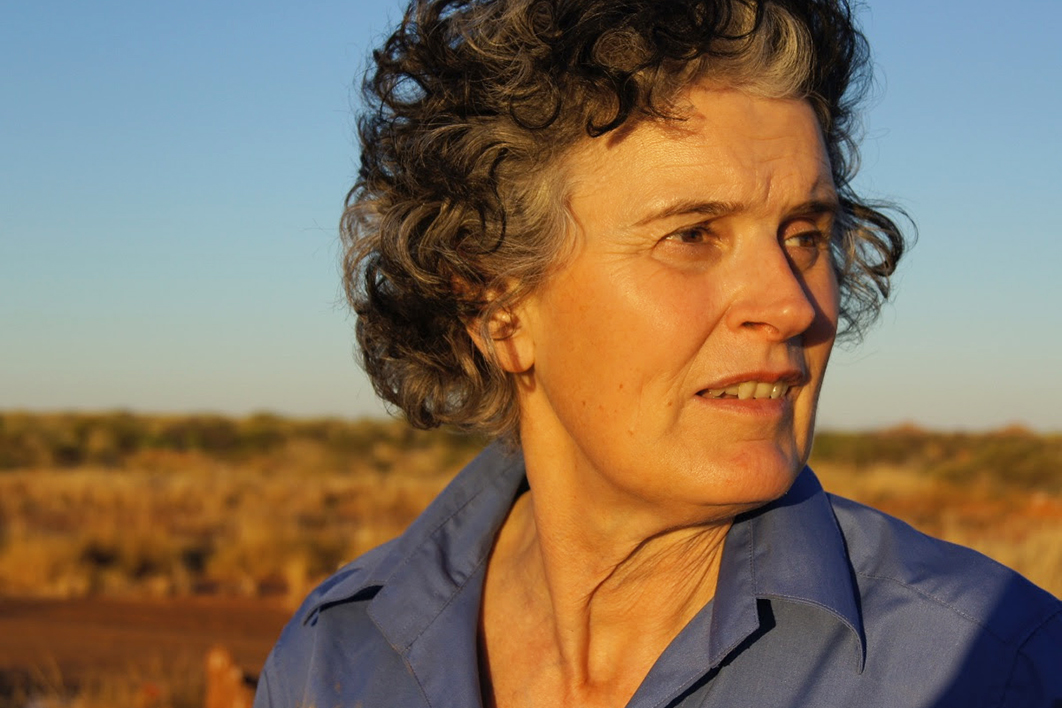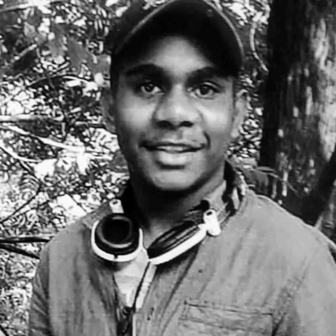Mandy Martin (1952–2021) painted to the end, determined to complete vital work in her lifelong campaign to lift the environmental consciousness of her fellow Australians. A landscape artist of national stature, she died last month at the age of sixty-eight after a recurrence of cancer. With the support and love of her husband, farmer and conservationist Guy Fitzhardinge, she was able to stay on their farm in the central-west of New South Wales until her final days, spending time with her family, generously receiving visitors when she was able, and painting in her studio from a wheelchair. Her final large-scale collaborative work will premiere in Australia in November.
One of Australia’s finest landscape painters, she was an extraordinarily gifted artist: versatile, productive, bold, subtle and profound. Our appreciation of her artistic achievement will only grow with the years. The intensity and beauty of her work is breathtaking, whether it be a panorama of central Australian desert ranges, an Antarctic iceberg, a dark industrial landscape or an exploding oil platform.
She was renowned as the artist of the largest commissioned work in the Australian parliament, the twelve metres by three metres Red Ochre Cove (1987) which hangs in the main committee room. Beneath its luminous presence, which features a shaft of light that references Tom Roberts’s Opening of the First Parliament of Australia (1903), our politicians and bureaucrats are routinely forced to reveal their failings. During the televised reports of Senate hearings on the nightly news, you can lift your eyes from their humiliations and gaze instead into the exhilarating otherworld of Mandy Martin’s art.

Mandy Martin, Red Ochre Cove, 1987, oil on canvas, Parliament House, Canberra. Click to enlarge
Mandy’s early works were on paper and often in the form of political poster art; later she took to oil painting and produced sensitively observed landscapes, often on very large canvases. Her mother, Beryl Martin, was a watercolourist and her father, Peter Martin, a professor of botany at the University of Adelaide. Years of accompanying her father on scientific field trips honed Mandy’s eye for ecological detail. From the 1990s she brought together her political and ecological sensibilities in a powerful series of “environmental projects,” as she called them.
Guy Fitzhardinge, whom she married in 1996, who brought to their partnership a deep knowledge of the land and its management, became an essential and enabling collaborator. As well as being a beef farmer, Guy was a director of Bush Heritage Australia, a member of the Commonwealth Threatened Species Scientific Committee and a director of Meat and Livestock Australia, among many other public roles.
Martin produced such a rich and varied oeuvre that it is impossible to encompass it here. But her environmental projects are worthy of special notice, and it was my good fortune — along with many other writers, scholars and scientists — to be invited to contribute to them. Mandy and Guy’s home in Wiradjuri Country near Mandurama, with its sweeping views across white box woodlands towards Mt Canobolas and Orange, became a salon, a place of art, nature, productivity and good conversation.
There was a fine beef herd in the paddocks, sugar gliders putting on a nightly show in the gums, superb parrots flitting past like darts, Mandy’s art on the walls, the latest literature on Guy’s shelves, a white box log in the fireplace, a great leg of hogget in the oven, a cherry pavlova on the table and gatherings of people passionate about the land and its future.
Mandy, always zinging with electric energy and fun, had a flair for creating this chemistry on tour as well: her artist’s caravan would unfold itself — alongside her famous ironing-board easel — in some of Australia’s most remote landscapes. Multidisciplinary conversations enabled by the art would then break out around the campfire and under the stars, leading ultimately to new, rich insights and significant literary, artistic and political outcomes.
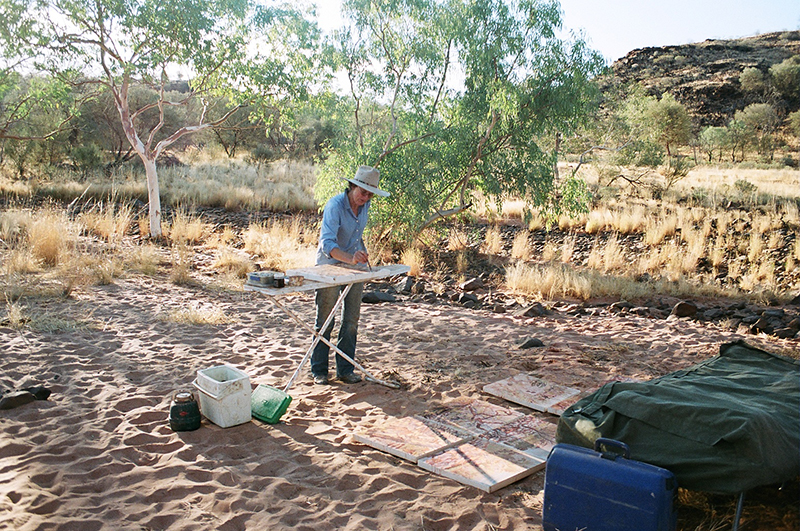
Shadows lengthen as Mandy Martin finishes her day’s work back in camp at the Mulligan River, Cravens Peak Reserve, 2009. Tom Griffiths
Mandy’s imagination was already turning inland in the late 1980s, but from the mid 1990s she launched a triptych of projects that ventured beyond the Darling River in northern New South Wales to the edge of the Simpson Desert. Each of them — Tracts: Back o’Bourke (1997), Watersheds: the Paroo to the Warrego (1999) and Inflows: the Channel Country (2001) — involved a fieldtrip, a travelling gallery exhibition and a published booklet and were supported by Peter Haynes as director of the Canberra Museum and Art Gallery. I was invited to join the last two as a writer and was thus given a rigorous education in the aesthetics, history and politics of the Australian inland.
Guy Fitzhardinge seems to know everyone across outback Australia and so we travelled from homestead to homestead, walked the paddocks, engaged with the ecology and listened to the locals — under their verandahs, in their kitchens and by their firesides. He shares Mandy’s conviction that conservation is an urgent national priority, believing that productivity, ecology and aesthetics have a beautiful relationship and that you need people on country to look after it. As well as being an innovative farmer, he has a doctorate in environmental sociology and the ability to talk to people from all walks of life.
Mandy’s art grew out of her passionate engagement with both landscape and people; thus her painting was intensely social and self-consciously historical. People rarely featured in her landscapes but human feelings and beliefs framed them. She saw herself in a lineage of explorer-artists (especially Ludwig Becker, who travelled with Burke and Wills), and so planned “expeditions” and painted a series, numbering the canvases in the sequence of a journey.
Country and conversations energised her creativity, and the public character and momentum of an expedition placed her under daily pressure to produce. She relished having to sculpt her art out of the circumstances of the travelling day; it had to be swift, opportunistic and impressionistic, alert to mood and moment, light and sky, lunch and dinner.
Her creativity was visible and public and social, the dogs and children played around her feet and an impromptu painting lesson for a nine-year-old was conducted on the side. Mandy painted as we ate, as the billy boiled or under threat of dusk. And she also painted under command. For it was her deliberate strategy on this trip to ask landholders to choose her sites and scenes. She encouraged local people to take her to their special places and allow her to paint them.
Thus her art often depicted beloved scenes, places of significance to inhabitants. This generated further pressure, of course. Her hosts had expectations, especially about the portrayal of favourite spots. They would review the progress of a painting over her shoulder or with a grave sense of ceremony at the end of the day.
I remember how one gravelly voiced grazier of the Channel Country, Sandy Kidd, paced like a restless beast around the finished canvas of his favourite waterhole as it lay on the concrete floor outside his home in the fluorescent light after dark. He had even graded the track to the spot that day to ease the artist’s way. By the waterhole that morning, sitting on the newly graded earth where a deadly snake had just slithered, he looked around with pride. “I wouldn’t call the king me uncle in this place,” he announced. “I couldn’t catch a cold here.” Later, as we awaited dinner at his home, he handed us beer cans spattered with blood from the meat chiller.
Finally, the moment had come to see what the artist had done. With drink in hand, Sandy circled the finished canvas, approaching it from every angle and looking at it from the corner of his eye as if trying to take it by surprise. In a Shakespearean stage whisper, he muttered, “This intrigues me, this does!” Then, nervously gesturing towards the painting as if it were alive, he declared, “This puts emotion into me. I come over all emotional looking at that. The Channels, eh? I didn’t know I loved them so much till they tried to bugger them up.”
In 1996, Mandy and Guy both spoke at a scientific workshop held nearby in Windorah, where local landholders, Aboriginal people and scientific visitors offered “an ecological perspective on Cooper’s Creek.” The workshop was coordinated by locals and responded to the environmental threat posed by plans from Currareva station to develop irrigation for cotton farming. The community came together impressively in defence of their wild rivers — they surprised themselves just as Mandy’s painting surprised Sandy Kidd.

Mandy Martin, Coopers Creek on Currareva Station, 2001, oil, ochre, pigment/linen, 90 x 330 cm.
Crusty pastoralists admitted to emotions. The mayor of the Barcoo Shire, Bruce Scott, used words like “braided” and “anastomosing” and “ephemeral,” adapting the words of urban professionals to advocate the special attributes of their water system. One Cooper pastoralist, full of genuine wonder, called the channels “anastomazing.” And they are! The Cooper, Diamantina and Georgina are the three great rivers of the Channel Country, flaring out into myriad braided channels, revealing an intricate web of arteries across a vast landscape. Aerial photos of the terrain look like microscope slides of organic tissue.
This is a boom-and-bust ecosystem, an arid land animated by waterflows from elsewhere, a place where monsoonal rain falling hundreds of kilometres away to the northeast periodically floods down dry channels, bringing a spectacular pulse of life to the plains and a precious, intense productivity. The flush of water occasionally reaches all the way to the saltpan of Lake Eyre, a continental rain gauge. Constituting almost a fifth of the Australian landmass, the Lake Eyre basin is the largest inland draining system in the world. Aboriginal people hold up the open palm of their hand to represent the basin, their fingers signifying the rivers that drain into it.
You need science, art and imagination to understand an ecosystem of such scale. In winning the battle of the Cooper at the turn of the millennium, Mandy Martin’s art was as important as Richard Kingsford’s surveys of river birdlife or Chris Dickman’s long-term studies of desert marsupials or Bruce Scott’s regional political advocacy or the Gorringe family’s testimony of deep Aboriginal attachment. They all successfully argued for the importance of “going with the flow” in arid Australia, and they did so by bringing together science and art, ecology and emotion, economy and history. Channel Country pastoralists found themselves beginning sentences with the words: “I’m not a radical greenie, but…”
In 2010, further field trips to the Channel Country and new interdisciplinary work with fifty local and visiting experts culminated in the publication of a large and beautiful book, Desert Channels: The Impulse to Conserve (edited by Libby Robin, Chris Dickman and Mandy Martin). Martin’s canvases — designed in four sets of four and presented as gorgeous interludes between essays — were all painted on location at Ethabuka and Cravens Peak on the eastern edge of the Simpson Desert, and this time she deliberately chose “ordinary or unsensational places to paint, places encountered by chance rather than design.” She wanted to capture the accidents of nature and the intricacies of ecology, to help people feel “the sensuousness of texture.”
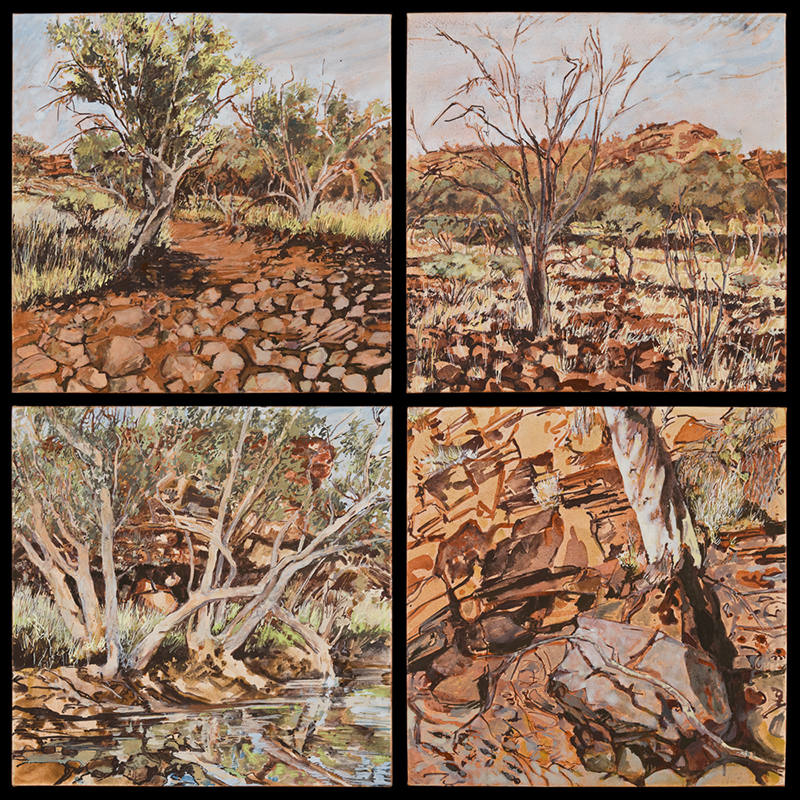
Mandy Martin, S-Bend on the Mulligan River, Toko Range, Cravens Peak Reserve 2, 2009, pigments/ochres/acrylic on canvas, 100 x 100 cm.
Mandy was striving to generate a new vocabulary and palette suited to the arid zone. Aesthetic evaluation, she argued, should be valued alongside scientific assessment, and both rely upon processes of sampling and re-sampling, consistent methodology and the patient accumulation of data. Mandy painted four canvases in sequence in each location, tramping back and forth between the different viewpoints, labouring for up to ten hours a day in the searing sun.
Martin was a researcher and a theorist, an artist-scholar, an esteemed speaker at international environmental history conferences and an adjunct professor at the Fenner School of Environment and Society at the Australian National University. South African environmental historian Jane Carruthers, who contributed to Mandy’s environmental projects, wrote of how the artist can partner the historian by fostering “interdisciplinary collaborations between the written and visual,” empowering others to think visually “and even to produce art.” Martin drew out the artistic potential of all her collaborators.
Great art breaks down barriers and opens minds, liberates people to see and feel in new ways. It is an effective political tool because it transcends politics. Mandy’s opening trio of environmental projects focused on settler lore and aesthetics, on the wisdom as well as failings of imported environmental visions in Australia. Her painting practice mobilised and elaborated traditions within the history of art: plein air painting, artists’ camps and documentary and scientific expeditionary art. Her work connected in this way not only with the likes of Ludwig Becker, Sir Thomas Mitchell, Conrad Martens and Eugene von Guérard, but also with the camps of the Heidelberg School, the multi-disciplinary expeditions of Russell Drysdale and John Olsen, and the immersive materiality of John Wolseley.
Did she relish the gendered intervention of her ironing board? Surely this early practitioner of feminist art did. Her ironing board was her stage, a place of theatre erected in the middle of the camp from which she could survey the scene and interact socially with her team, always with an eye for the comfort and interests of others. She directly addressed the landscape, like a conductor with her score. The horizontal board was perfect for the splash and wash of colour, the deft sketch of detail, and the urgent and fluent capturing of raw material and impressions which she later refined in her studio. She would use the sand at her feet, grind ochres, work blown dust and pollen into the paint and build layers from the substance of the place in which she stood.
Keenly conscious of how the land she painted was already layered with representation, Mandy often inscribed and painted words on her canvases that conjured connections to these cultural histories. Perhaps they were Becker’s words or Mitchell’s evocations of the seventeenth-century Italian painter Salvator Rosa (his favoured lens for the new land), or the latitude and longitude of the place, or some topographical annotations, or descriptions of its geology and vegetation from contemporary scientists and scholars. In this way she brought her painting into direct dialogue with science and literature, a conversation also enacted by her fieldtrips.
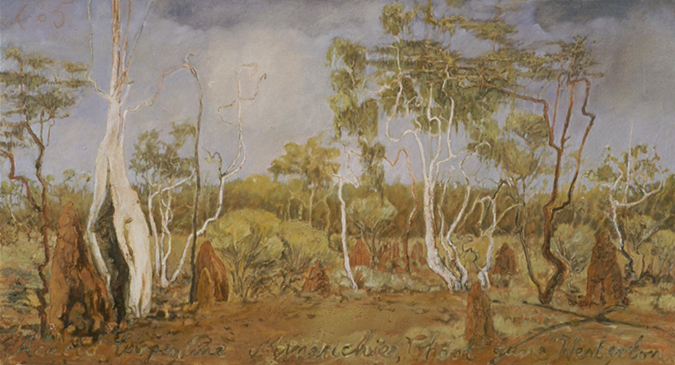
Mandy Martin, Westerton Ram Paddock 2, 2001, oil, ochre, pigment/linen, 90 x 165 cm.
David Malouf wrote in 2002 of her conscious cultural layering and Mandy, in turn, wrote in 2013 of how she and fellow artist David Leece were influenced in their choice of prospect by their shared reading of Malouf. Malouf perceived that the ambition of the literate European explorers of Australia was “to gather these new lands into a world of feeling that would be continuous with the culture they had brought with them.” Martin honoured that quest and built upon it, but she also took it in radical new directions.
Increasingly, she sought the guidance and collaboration of Indigenous artists on Country. In 2004, environmental historian Libby Robin, archaeologist Mike Smith and ecologist Jake Gillen travelled with Mandy and Guy to Puritjarra, an ancient rock shelter in the red sandstone Cleland Hills, 350 kilometres west of Alice Springs. Puritjarra is an extraordinarily significant place that, from the mid 1980s, deepened the chronology of human history in the centre of the continent from 10,000 to 35,000 years and provided evidence that people managed to sustain civilisation in the central deserts during the last ice age.
This expedition to such a remote site was a cross-cultural experiment, not just in bringing together art and science, but also in collaborating with the Indigenous owners, Ikuntji artists from Haasts Bluff. Their traditional knowledge, interpreted in acrylics on canvas especially for the project, was brought alongside Martin’s “European” vision where it generated a respectful dialogue about aesthetics, economy and history in a place of national significance. The paintings by Narputta Nangala Jugadai, Daisy Napaltjarri Jugadai, Molly Napaltjarri Jugudai, Anmanari Napanangka Nolan, Eunice Napanangka Jack, Colleen Napanangka Kantawarra, Alice Nampitjinpa and Linda Ngitjanka Naparulla are visually stunning and environmentally precise about their home.
Mandy, the visiting artist, painted her own breathtaking panoramas of the range and also collaborated with each of her visiting team members to produce multi-panelled canvases inflected with their distinct visions: archaeological, historical, pastoral, botanical. The boldness of this collaborative intervention in our national cultural life, captured in an exhibition at the Araluen Arts Centre in Alice Springs and the book Strata (2005), was remarkable.
Further ambitious, cross-cultural ventures followed. In 2007, renowned Kimberley artist Janangoo Butcher Cherel invited Mandy to paint alongside him in Fitzroy River Valley Country: “It led to one of the most extraordinary working relationships I have ever been lucky enough to experience,” remembered Mandy. On the Puritjarra project, the Ikuntji artists had done their painting at Haasts Bluff, but here Mandy was shoulder to shoulder with Mangkaja artists painting the same landscapes at the same time of day. The following year, three generations of Cherels came out to Painters Rock on Jalnganjoowa (Fossil Downs) to continue this journey into memory, country and the alchemy of art.
Southwest of Fitzroy Crossing is a big desert lake named Paruku (Lake Gregory), a World Heritage wetland in northwest Australia and “a human home of great antiquity,” a setting that geomorphologist Jim Bowler had long seen as a northern echo of his investigations into ancient human history at Lake Mungo. During 2011 and 2012, a project team of fifty artists, scientists and Walmajarri people from the Mulan community worked together on the Paruku Indigenous Protected Area beside the lake.
Alongside Mandy Martin, the curators and editors of the project were artist and writer Kim Mahood (who had a long association from childhood with Paruku and the Tanami), desert ecologist Steve Morton (who researched fire ecology in the Tanami and worked with Anangu people on the Uluru Fauna Study), and anthropologist John Carty who has lived and worked with Mulan people since 2002. Other visiting contributors included Guy Fitzhardinge, Jim Bowler, archaeologist Mike Smith, American writer and curator Bill Fox, ethno-ecologist Tanya Vernes, conservationist David Rickards, and creative artists Laura Boynes, Alexander Boynes, Faye Alexander, David Leece and David Taylor.
To draw together such a team was extraordinary in itself, but to do so on Country in a productive relationship with the Indigenous owners shows the sheer power of art, and of great artists, in energising genuine collaboration. Morton, Martin, Mahood and Carty wrote in their introduction to Desert Lake: Art, Science and Stories from Paruku (2013) that Paruku resonated with the most important questions of contemporary Australian life: “How are we to live with our shared history, our shared environments, our shared homes, in difference and respect? And how do we tell these stories together?” The Walmajarri people and artists welcomed and worked with the visitors, not only guiding the project, but redirecting it in several crucial ways. They had faith that multiple perspectives would generate “a kind of truth, a type of honesty about how things are in Australia now.”
These three innovative cross-cultural art projects focused in turn on deep archaeological perspectives, contrasting aesthetic visions, and social and ecological belonging. The next such project — known as Arnhembrand — brought art to bear on contemporary environmental challenges in caring for Country. Guy Fitzhardinge was chair of the Karrkad-Kanjdji Trust, which supports traditional owners in land management and cultural conservation in the Djelk and Wardekken Indigenous Protected Areas in western Arnhem Land. He knew that community members ranked “empty country” as the most severe threat to the maintenance of healthy country. His own research had for years critiqued the separation of social systems from ecosystems that underpins much Eurocentric thinking. In 2013 Mandy Martin was approached to work with Bininj people in western Arnhem Land as she had with Walmajarri people at Paruku, and in 2015 she held a drawing workshop supported by Djelk Rangers who saw the opportunity to tell stories about the cultural and land management work they were doing.
By 2017, nearly eighty Bininj people had become involved as performers and artists working with Martin and fellow Balanda artists Alexander Boynes, Laura Boynes and David Leece. Paintings, video works and a commissioned woven mat were created, and a mixture of Bininj and Balanda techniques were used. Mandy described the joy of watching the Bininj artists prepare their traditional bush brushes from speargrass slashed from the seafront and then deploy them with fluid precision. The team also used “the latest fluorescent Anthropocene pigments” mixed with traditional ochres to tell novel, confronting stories about invasive species, new fire regimes and changing climates.
As the project historian Billy Griffiths put it, “buffaloes, pigs, feral cats and cane toads have trampled, chewed, rubbed and wallowed their way across a delicate ecosystem… In the absence of traditional burning, fire, too, had become feral. The cultural landscape had transformed into a modern wilderness.” The project work, which was exhibited at Australian Galleries and published as Light — Stone — Fire (2017), has been archived by the Center for Art + Environment at the Nevada Museum of Art where the director Bill Fox (a brilliant interpreter of Martin’s work) saw parallels in challenges faced by traditional Indigenous communities around the world, “whether it is the Inuit of Nunavut in the Canadian Far North, the islands of Vanuatu, or the scattered settlements of Arnhem Land.” Fox sees his museum as preserving information about how to achieve resilience in the face of change “and passing it down from generation to generation, and from place to place in order that we might all survive.”
After each of these exhilarating trips away, Mandy and Guy would return to their home amid the undulating white box woodlands, perched with its view northeast towards Orange. Winking at night on their horizon, bordering their property and expanding every year, was the Cadia Hill gold mine, the largest in the southern hemisphere. Mandy’s lifelong critical engagement with industry was now taking place in her own backyard.
True to form, her relationship with the mine owners was honest, forthright and constructive — and mediated through art. She completed a series of one hundred small canvases of the Cadia region, fifty of them depicting the local Belubula River in a golden palette using river sand and natural pigments, and the other half portraying the mine in a copper palette, using tailings from the dam and sulphide concentrate from the mine’s sag mill. She worked with Wiradjuri artists, and collaborated on canvases with neighbouring Indigenous artist Trisha Carroll. She launched further interdisciplinary projects combining art, science and storytelling that focused on the local mining landscape: The Lachlan: Blue-Gold (2003), Land$cape: Gold & Water (2003) and in 2016 a broader retrospective entitled Homeground, in which Mandy reflected on twenty years living in the Central West and selected twenty of her paintings of the region (out of more than 200) for exhibition.
As a boy, Guy would explore the rocky twists and turns of the Belubula River, whose name captures the sound of a gurgling, flowing stream, and he grew up knowing and romancing the traces of past mining in the landscape. But Cadia Hill was different in its sheer scale of mining and earth-moving and also in its amorphous international corporate elusiveness. In a beautiful essay for the Land$cape catalogue, Guy reflected that he now had “a neighbour who I do not know and probably will never know” and whose process of wealth creation lay far outside the local ecosystem or community. Nevertheless, he was determined “to explore and enlarge what we do have in common.”
Mandy, with fierce commitment, used her art to humanise the corporate face of the mine so that she could engage with it. And the argument she and Guy made through their work was that “the actual value of the Cadia region landscape is aesthetic, not material, and that the natural values of the river and native habitat if preserved, would in the long-term, outweigh the value of gold extracted from the mine.” It is a simple statement that is incontrovertibly true — if one can see long-term, can value the more-than-human, and can understand that Country needs people.
While plumbing the depths of her local region, Mandy was also prosecuting global environmental issues. Human survival in the face of massive anthropogenic climate change was a vital and urgent concern of hers for decades. In Australia, business and the arts have moved into the vacuum left by federal government denial of climate change, as Libby Robin has analysed, and are creating new partnerships such as a series of biennial Climarte Festivals, the first of which was held in 2015.
Mandy, working with Alexander Boynes and composer-musician Tristen Parr, created a series of stunning, panoramic performance pieces that combined traditional oil painting with video projection and a music composition. In Luminous Relic, a factory belching smoke gradually gave way to a collapsing Antarctic ice shelf, and in Rewriting the Score a Gondwanan fern forest morphed into an open-cut coalmine that became ravaged by fire. This piece ended with Parr, wearing a mine worker’s hard hat, poignantly playing his cello in a landscape of fern, coal and fire. These performances are visual enactments of chaos theory: time and landscapes collapse before your eyes and the globe becomes whole, elementally. Standing in that gallery in Morwell in Victoria’s Latrobe Valley in 2019, shoulder to shoulder with locals, I listened to workers moved by art who were feeling their way towards a new politics.
Martin had first painted the Yallourn Power Station in the Latrobe Valley in 1991 and here she was, a quarter of a century later, returning to the land of brown coal to deepen her critique. It is testimony to the coherence of her career. Her art began as a radical commentary on industrial and corporate power, drawing on the responses of European Romantic poets and artists to the industrial revolution to portray contemporary industrial incursions upon the Great South Land. She explored the links between the dark, satanic mills that emerged in the late eighteenth century and the vulnerable, beautiful landscapes of Australia today. As Mandy made these explorations from the 1980s, the grim implications of anthropogenic climate change burst upon us and made those links manifest in the very air we breathe.
We might reasonably say, therefore, that Mandy’s art foresaw the full horror of climate change. Her canvases from the early and mid 1980s pictured chimneys, mining residue and industrial plants in sublimely beautiful settings and they prompted us to ask: are they abandoned? is this the past or the future? is that smoke or cloud in the sky? are those mountains natural or terraformed by industry? Martin was already investigating the blurred line between nature and culture; she was preparing herself for the Anthropocene. Science eventually caught up with her and she was ready. The Sublime is both beautiful and terrible, grand and grotesque; it has a violence at its heart that threatens everything. When Mandy painted an exploding oil platform, it was both a magnificent form of terrorism and an objective commentary on fossil-fuelled cupidity.
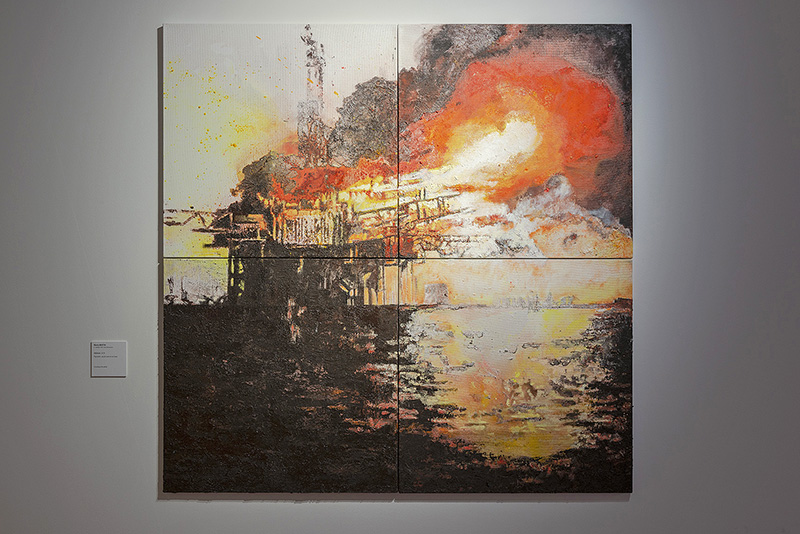
Mandy Martin, Oblivion, 2019, pigments, acrylic and oil on linen, 200 x 200 cm. RLDI
And it is also wonderful art. When Dorothea Mackellar wrote of her love of the wide brown land in her poem My Country (1908), she evoked “her beauty and her terror.” Living on the land Mandy knew those Australian extremes, the supreme skies at sunset and the aching earth in endless drought. As an artist in thrall to the Romantic Sublime, she explored the edge between awe and fear and her paint dripped with passion. As an environmental scholar she was sensitive to delicacy and complexity, urgency and deep time, and the fragility of the planet’s predicament, the beauty and the terror. As a human being, she was warm, funny, intelligent, loving. Mandy Martin was a remarkably original, courageous and generous Australian artist whose vision of our land, and of its past and future, is inspirational. •
